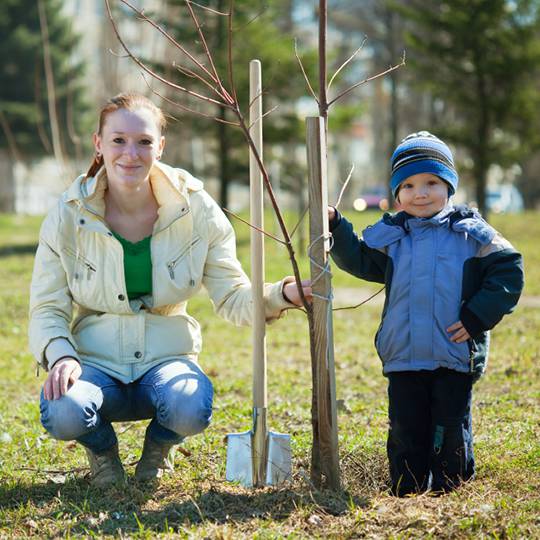How to Plant Bare Root Trees, Shrubs, and Rose Bushes
Posted
January 7, 2016

Bare root trees
Bare root trees are dug from the ground when dormant, usually in autumn, and their roots are shaken free of soil. Packed with their roots in moist material, bare root plants are most commonly shipped in autumn or early spring and can cost substantially less than a container-grown tree of the same size.
Here’s how to plant your bare root tree:
- Unpack the tree and remove all packing materials. Untangle the roots, then soak them in water for three to six hours without letting them dry out.
- Dig a wide hole that allows the roots to grow outward without crowding. Remove grass and turn the soil in a circular area 3’ in diameter around the tree to promote root growth.
- Plant the tree making room for the roots. Partially fill the hole and firm the soil around the lower roots. Avoid adding soil amendments, like peat, bark, fertilizer, potting soil, or chemicals.
- Shovel in the remaining soil, packing it firmly, but not too tight. Water your new tree regularly.
- After the soil has absorbed the water, spread 2” of protective mulch in the 3’ area around the tree’s base without touching the trunk.
- Keep the soil and mulch around the tree moist, not soggy. If there is dry weather in its first year, generously water at the drip line every seven to 10 days.
Shrubs
Shrubs add structure and dimension to your garden and can provide color, by way of flowers and foliage, as well. They are also surprisingly easy to install. Here’s how to plant your shrub:
Gather your materials:
- Spade
- Organic matter
- Bucket
- Mulch
- Turn over the soil and remove weeds in the planting area. Dig a planting hole twice the diameter and deeper than the shrub’s container.
- Soak the plant in its container in a bucket of water. Then remove the plant from its container and tease out its thickest roots. Plant the shrub at the same depth it was in its pot and fill the hole with soil. Water generously.
- Ensure that the shrub is upright and sitting in the shallowest spot in the hole. Gently firm the soil and water generously.
- Next, spread a mulch of organic matter, choosing a mulch type that best fits your needs.
Here are some popular options:
- Mature compost and manure are excellent at locking moisture and nutrients into the soil.
- Leaves, though low in nutrients, improve soil and retain moisture well.
- Bark suppresses weeds and breaks down slowly.
- Gravel makes for an attractive weed suppressant when used over landscape fabric.
Rose bushes
Planting roses is easier if you have prepared your rose bed properly. Choose a place to plant that is a safe distance from plants with large root systems. Here’s how to install your rose bush:
Gather your materials:
- Sand
- Compost
- Superphosphate
- Rototiller
- Hoe
- Pruning shears
- Ensure your rose bed is in a well-draining site. Add sand to the soil if drainage is subpar and add compost or manure to increase its nutrient levels. Mix in superphosphate and till the soil to help the additions penetrate the soil (about 12” deep).
- Soak the plant’s roots in water for at least three hours before installation.
- Dig a hole measuring 2’ deep and 18” wide. Fill it with soil until it is 8 inches from the surface and gently pack the soil in place, mounding it around the base of the bush, forming a cone shape.
- Plant your rose bush after the last frost of the spring. Remove the plant from soaking in water and cut off 1” from each root tip to encourage new growth. Plant the bush in the hole, letting the roots drape over the cone-shaped soil. Next, cover the roots with soil and fill the hole with water two times. Finally, fill the rest of the hole with remaining soil.